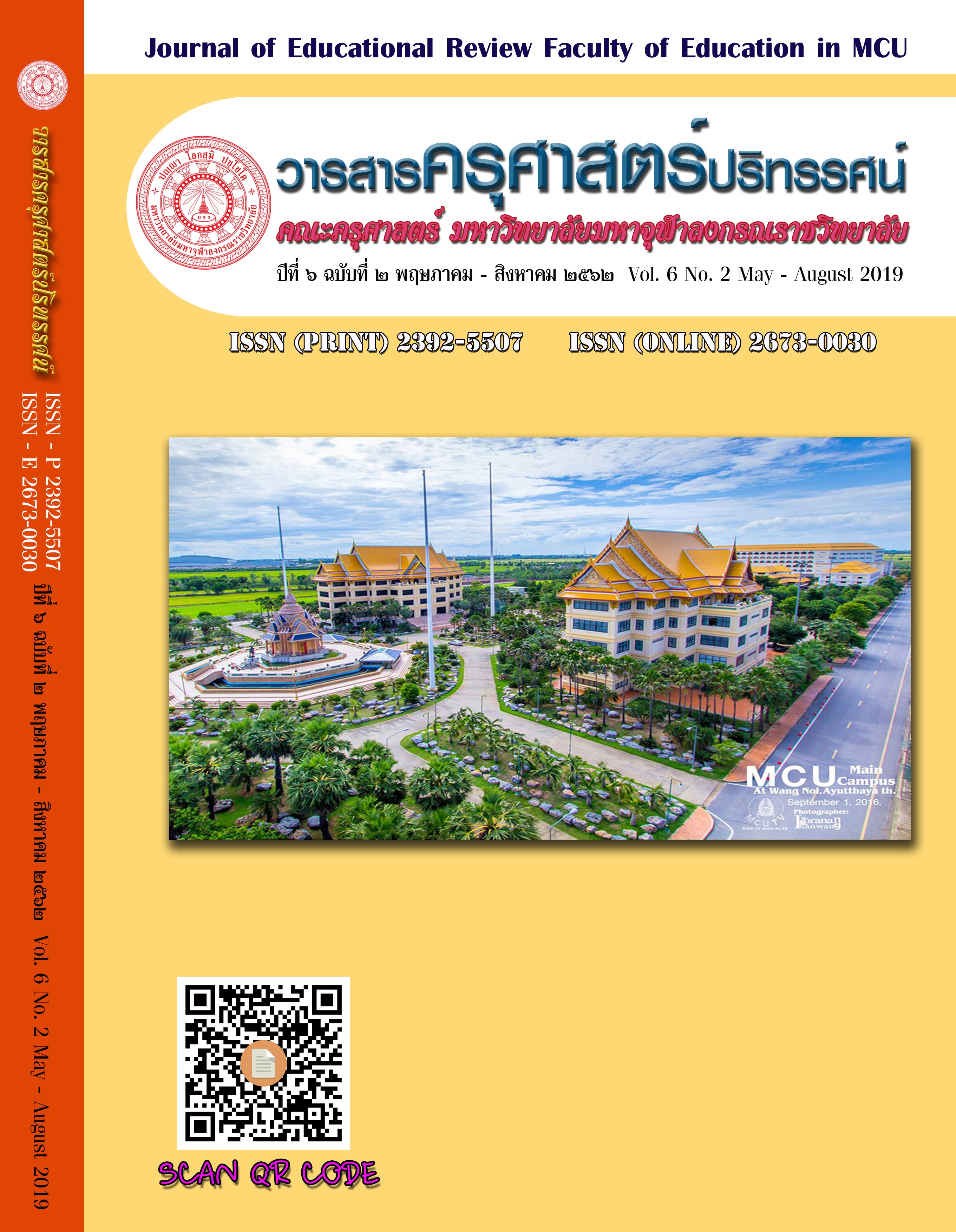Relationship between Organizational Culture and Creative Learning of Students at Alternative Secondary Schools in Bangkok Metropolis
Main Article Content
Abstract
The purposes of this research were to study: 1) levels of organizational culture of alternative schools in Bangkok Metropolis, 2) levels of creative learning of these students, and 3) relationship between organizational culture and creative learning of the students. A sample of 88 teachers from these secondary alternative schools was selected by a proportional stratified random sampling. The instrument for data collection was a questionnaire constructed by the researcher. The statistics used for data analyses were percentage, means, standard deviation, level, and Person’s product moment correlation coefficient.
The research results were as follows:
1) Organizational culture of all aspects was rated at the high level; from which the aspect of beliefs had the highest means, followed by that of organizational culture of values.
2) All aspect of student creative learning was also rated at the high level; from which the aspect of child–centered creative learning was ranked at the top, followed by that of life-long creative learning.
3) The relationship between organizational culture and creative learning of these students was at the highest level with the statistically significant level of 0.01.
Article Details
ทัศนะและความคิดเห็นที่ปรากฏในบทความในวารสารฉบับนี้ถือเป็นความรับผิดชอบของผู้เขียนบทความนั้นเพียงผู้เดียว และไม่ถือเป็นทัศนะและความรับผิดชอบของกองบรรณาธิการ
กองบรรณาธิการขอสงวนสิทธิ์ในการคัดเลือกบทความลงตีพิมพ์และจะแจ้งให้เจ้าของบทความทราบหลังจากผู้ประเมินบทความตรวจอ่านบทความแล้ว
ต้นฉบับที่ได้รับการตีพิมพ์ในวารสารครุศาสตร์ปริทรรศน์ คณะครุศาสตร์ มหาวิทยาลัยมหาจุฬาลงกรณราชวิทยาลัย ถือเป็นกรรมสิทธิ์ของคณะครุศาสตร์ มหาวิทยาลัยมหาจุฬาลงกรณราชวิทยาลัย ห้ามนำข้อความทั้งหมดหรือบางส่วนไปพิมพ์ซ้ำ เว้นเสียแต่ว่าจะได้รับอนุญาตจากมหาวิทยาลัยฯ เป็นลายลักษณ์อักษร
References
จรีพร นาคสัมฤทธิ์. (๒๕๕๕). กระบวนการบริหารโรงเรียนทางเลือกตามแนวคิดการบริหารที่เน้นความเป็นมนุษย์และแนวคิดการศึกษามนุษยนิยม. วิทยานิพนธ์ครุศาสตรดุษฎีบัณฑิต. จุฬาลงกรณ์มหาวิทยาลัย.
ชูศรี วงศ์รัตนะ. (๒๕๕๓). เทคนิคการใช้สถิติเพื่อการวิจัย. กรุงเทพมหานคร: บริษัทฐานบัณฑิตจำกัด.
เชษฐ์ ศิริสวัสดิ์. (๒๕๕๕). การสอนให้คิดและสร้างสรรค์โครงงานวิทยาศาสตร์ด้วยการเรียนรู้เพื่อสร้างสรรค์ด้วยปัญญา. วารสารศึกษาศาสตร์, (๑ ตุลาคม ๒๕๕๕-มกราคม ๒๕๕๖),
๑-๑๔.
วัชรพล ศุภจักรวัฒนา. (๒๕๔๙). วัฒนธรรมองค์การ: ข้อสังเกตในการบริหารงานโครงการ. วิทยานิพนธ์รัฐประศาสนศาสตรมหาบัณฑิต. สถาบันบัณฑิตพัฒนบริหารศาสตร์.
วิรัช สงวนวงศ์วาน. (๒๕๕๑). การจัดการและพฤติกรรมองค์การ. กรุงเทพมหานคร: เพียร์สันเอ็ดดูเคชั่น อินโดไชน่า. แปลจาก Stephen P. Robbins and Mary Coulter. (2002). Management. New Jersey: Prentice Hall.
ศศิมา สุขสว่าง. (๒๕๖๑ เมษายน ๑๙). ขั้นตอนเพื่อพัฒนาการคิดเชิงนวัตกรรม. ๓.https://www.sasimasuk.com.
สุนทร วงศ์ไวศยวรรณ. (๒๕๔๐). วัฒนธรรมองค์การ: แนวคิด งานวิจัย และประสบการณ์. กรุงเทพฯ: สำนักพิมพ์โฟร์เฟซ.
Arroba, T. and J, Kim. (1992). Pressure at Work: A Survival Guide for Manager.
(2nd ed.). London: McGraw-Hill Book Company.
Dunn, D.S. (2001). Statistics and Data Analysis for the Behavioral Sciences.
New York: McGraw-Hill. Cited in เพียงใจ ศุขโรจน์. (๒๕๕๐). ระเบียบวิธีสถิติทางการศึกษา. กรุงเทพมหานคร: ศูนย์ตำราและเอกสารทางวิชาการคณะครุศาสตร์ จุฬาลงกรณ์มหาวิทยาลัย.
Hellriegel, D., J. W. Slocum, Jr. and R. W.Woodman. (1995). Organizational Behavior. (7th ed.). Minneapolis: Wes Publishing Company.
Krejcie R. and D.W. Morgan. (1970). Educational and Psychological Measurement. New York: University of Minnesota.
Pheysey, D. C. (1993). Organizational Culture: Types and Transformations. London: Routedge.
Robbins, S.P. (1995). Organizational Behavior: Concept, Controversies and Application. (7th ed.) New Jersey: Prentice Hall, Inc.


